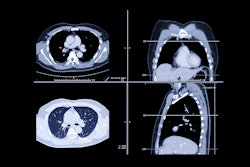Wednesday, December 4 | 11:40 a.m.-11:50 a.m. | SSK17-08 | Room S505AB
PET/MRI using a dedicated pulmonary MRI protocol and PET/CT show good agreement on thoracic tumor-node-metastasis (TNM) staging for non-small cell lung cancer (NSCLC) patients, according to a study from Germany.PET/CT and PET/MRI were substantially comparable in determining primary tumor size and performed well in quantitatively measuring FDG uptake, concluded Dr. Philipp Heusch, from the Institute of Diagnostic and Interventional Radiology at the University of Dusseldorf, and colleagues.
In the study, 38 patients with confirmed cases of NSCLC underwent FDG-PET/CT followed by FDG-PET/MRI, which included a dedicated pulmonary MRI protocol. TNM staging was performed in separate sessions for PET/CT and PET/MRI by two readers.
Of the 38 cases, PET/MRI and PET/CT agreed on T stage in 33 patients (87%). The modalities agreed on N stage in 32 cases (84%) and on M stage in 35 cases (92%).
Compared with PET/CT, PET/MRI downgraded T stage for three patients (8%), N stage for three patients (8%), and thoracic M stage for three patients (8%). PET/MRI also upgraded T stage for two patients (5%) and N stage for three (8%).
Because the choice of therapeutic options for NSCLC is based on the individual tumor stage, the "comparability of thoracic TNM stages and primary tumor sizes assessed by PET/CT and PET/MRI is essential," Heusch and colleagues noted.



















